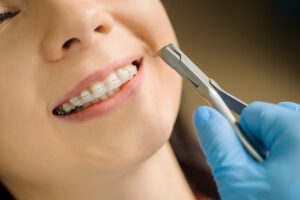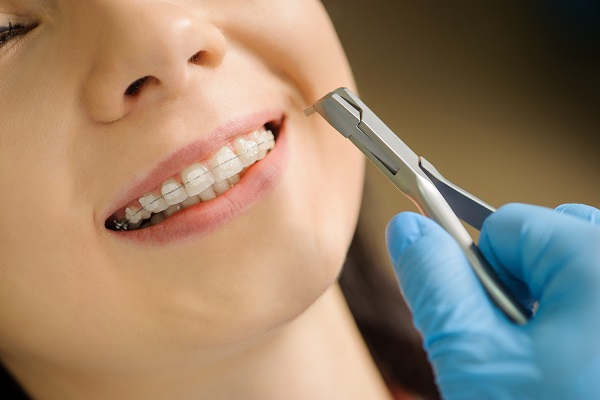Braces aftercare is a vital part of your orthodontic treatment. It can prevent oral hygiene problems, like plaque and tooth decay, and prolong your treatment time.
It involves a healthy diet, regular brushing, and dental wax to cover rough-feeling areas. The aim is to prevent food from sticking in your teeth and brackets. Call the pros at boca Dental and Braces now.

Brushing is the most important part of maintaining good oral hygiene while wearing braces. It can be hard to keep up with brushing your teeth when you have braces, but it is essential for preventing gum disease and tooth decay. Food particles get trapped in the tiny gaps between your teeth and gums or underneath your braces, leading to bacteria build-up that can cause bad breath and decalcification of your tooth’s enamel. Brushing twice daily for about two minutes ensures your teeth and gums stay healthy.
When brushing, you need to take extra care to remove all the food stuck in your braces. Using a fluoride mouthwash after brushing is also a good idea, as this will help kill germs and prevent cavities. Be sure to rinse your mouth thoroughly before and after using mouthwash. If you are still getting food particles stuck in your braces after brushing, try using a disclosing tablet to highlight the areas where plaque and food are trapped.
It is also very important to avoid hard foods, such as popcorn, ice, hard crusts, and boiled sweets, as these can break the brackets or dislodge them from the teeth. We advise you to cut up these kinds of foods before eating them or wait until after your treatment. It would also be best to be careful with colored foods and drinks, as they can stain the elastics on your braces. If you notice that your elastics are stained, we can always change them for clear ones at your next appointment.
In addition to brushing, you should also be flossing daily. This is particularly important if you have a lingual brace, as food can easily get trapped in the tiny gap between the upper and lower archwires and the brackets. If you have a lingual brace, your dental professional can show you how to floss correctly or recommend a specific flossing product designed for orthodontic work.
After you floss, inspecting your teeth and braces in the mirror is a good idea to ensure that all food particles have been removed. This can be a helpful way to catch problems like loose wires or broken brackets before they become more serious.
Flossing is an important part of your dental routine, especially when you have braces. It removes food debris and plaque your toothbrush can’t reach, preventing gum disease and tooth decay. It also contains sugar and excess bacteria from degrading the bond that holds your brace to your teeth, helping your treatment progress on schedule.
Getting into the habit of flossing with braces can take some practice, but it doesn’t have to be difficult. Your orthodontist can show you the best way to floss with braces, or you can purchase a floss threader designed for braces (Superfloss is a popular brand). Once you’ve got the hang of it, allow yourself around 15 minutes daily to ensure your teeth and gums are clean.
Aside from brushing your teeth, avoiding hard foods is also important. Biting into apples, carrots, and the like can cause abrasions to your gums, which will hurt and can also shear off a wire or bracket. This could delay your treatment or require a return visit to correct the issue. Additionally, it’s a good idea to steer clear of chewing on hard things like pencils and ice.
If you’re having trouble with an abrasion, a piece of wax is a great solution. Tear off a small strip from the tube and mold it over the irritated area to provide a protective layer. Remember to change the wax regularly, as it can get gummy and sticky over time.
If you have persistent abrasions that don’t improve with the help of wax or your orthodontist has suggested you need to see a general dentist for a more permanent solution, please make an appointment for yourself as soon as possible. Poor hygiene can lead to permanent damage, so you must get your teeth and gums back to normal as quickly as possible.
When you have braces, a daily oral hygiene routine is important. Brushing and flossing help remove food particles and reduce bacteria, but mouthwash can add an extra step that helps keep your teeth cleaner. We recommend using an alcohol-free mouthwash for braces that contain fluoride. This will help strengthen your teeth and prevent cavities during your treatment time.
If you are new to mouthwash, we recommend reading the instructions on the bottle. They usually advise you to swish it around your mouth for 30 seconds to a minute before you spit it out. Make sure you swish it thoroughly to expose all areas of your mouth.
Typically, mouthwashes have several ingredients that help to kill bacteria, freshen your breath, and improve the health of your gums and teeth. Mouthwashes containing fluoride have additional properties to help reduce plaque and gingivitis and provide an extra layer of protection for your enamel.
Mouthwash should be used as a follow-up to brushing and flossing. It helps to remove any remaining food debris and can kill any bacteria left over from your meal. It is especially helpful for people with braces because it can help get in the small places that a toothbrush may miss.
Many people are curious whether mouthwash is safe while wearing braces. It is safe to use if you do not have metal braces. If you have metal braces, we suggest you only use an ADA-approved mouthwash containing fluoride. The ADA puts a seal on approved products so that you can be sure that it will not damage or tarnish your metal braces.
Several different mouthwash options are available, but we recommend Colgate Ortho Defense Anticavity Fluoride Rinse. This mouthwash is specifically formulated for people with braces, and it checks all the boxes: it is alcohol-free, contains fluoride, and helps to remove white spots and prevent cavities. It is the perfect mouthwash for braces!
Using braces wax is an important part of brace aftercare to protect tender areas inside your mouth. During treatment, the wires and brackets rub against your inner cheeks and lips and can cause pain and soreness. Wax provides cushioning protection to reduce this rubbing and prevent ulcers, which may lead to infection.
Dental wax is made from natural, non-toxic substances such as beeswax, paraffin, or carnauba wax. It is firm at room temperature but becomes flexible when warmed by the hand or tongue. It has no taste and is completely safe to ingest if accidentally swallowed.
Before applying wax, please wash your hands thoroughly with soap and water to ensure they are free of dirt and bacteria. It would be best to brush your teeth to remove any food debris.
Using your clean hands, pinch a small piece of wax and roll it between your fingers to soften it. Then, mold it around the bracket or wire, irritating your mouth. Be sure to use only a small amount of wax and avoid covering a large area. Too much wax can rub and may fall off inside your mouth.
Once the wax is in place, you can eat and drink normally. However, if the wire or bracket is still causing discomfort, you should remove the wax and call our office for an appointment. While eating, you should avoid chewing gum as this can stick to the braces and trap food particles.
If you have trouble locating a painful area, try standing before a mirror to help find the sensitive area. You can also look for bright red marks or swollen areas. By taking the time to identify these problem spots, you can protect them with wax before they develop into ulcers or infections. In addition, if you are wearing elastics, you should cover them with wax to prevent them from irritating the tissues of your mouth. Using these precautions allows you to have a successful orthodontic treatment without discomfort or injuries. You can also reduce your risk of these problems by keeping your braces as clean as possible and limiting your sugary foods.
